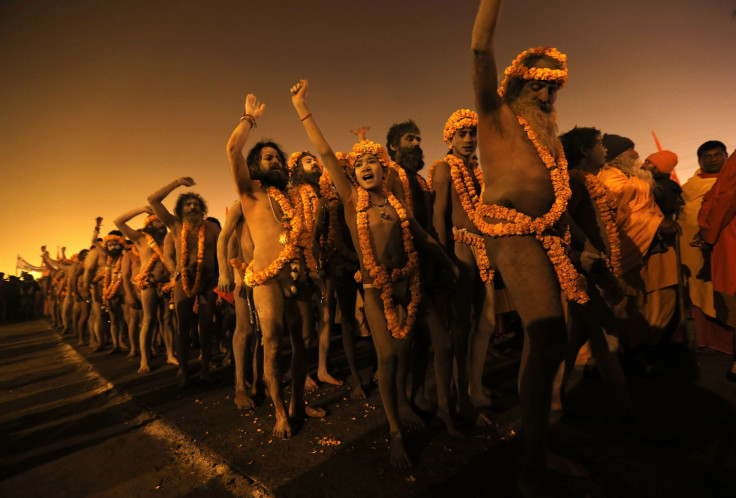Kumbh Mela: Case Study In Chaos Attracts Harvard Business School

The Maha Kumbh Mela is known as the biggest gathering of human beings in the world. The Hindu religious gathering is also a logistical nightmare, even when it does not turn deadly as it did on Sunday, when dozens were killed in a stampede at the Allahabad train station.
The Kumbh Mela is held every third year at sacred locations near rivers in India. Every twelfth year, the Maha Kumb Mela, the largest and by some accounts holiest of the Melas, is held in Allahabad, a city of 1.2 million in the Indian state of Uttar Pradesh. On the flood plains where the Ganga and Yamuna rivers meet with the Saraswati (a mythical, invisible river), a massive, functional city is built in a matter of weeks.
More than 12,000 police and paramilitary provide security in 14 zones cordoned off across 4,700 acres of land and criss-crossed with more than 70 miles of roads – all designed to cater to some 40 million Hindu pilgrims who will pass through the camp, gather on the banks of the rivers, bathe for about three minutes (there are guards timing them), and head home washed of sin.
Understandably for a gathering of this size, the event is wrought with real-time problems. Such unique phenomena drew a team from Harvard University to Allahabad this year to study the event.
The gathering’s name comes from the word Kumbh -- literally meaning ‘pitcher” in Hindi and a powerful and complex symbol in Hinduism; and Mela, meaning “fair.” The next Kumbh Mela will take place in 2015 at Nashik, a city about 75 miles northeast of Mumbai. The next Maha (Maha signifies “great”) Kumbh Mela will take place in Allahabad in 12 years.
In 1954 hundreds died and many more were injured in a stampede during the first post-independence Kumbh Mela, a tragedy that has been attributed to poor land-use planning. Already this year, the local government has reported that water pollution after ceremonial bathing dates has skyrocketed.
Since the last Mela in Allahabad, India’s population has grown by more than 200 million. This year is the first that will feature widespread use of mobile phones. In the past 12 years, the number of commercial airlines in India has more than doubled.
Harvard was interested in studying all the disparate aspects of the phenomenon. “This is a truly inter-departmental team,” explained Meena Hewitt, Associate Director of Harvard’s South Asia Initiative. There are scholars and students from the divinity school, as well as from the humanities, urban design, public health, and business schools.
The Harvard researchers dubbed the event a “pop-up megacity” and the first “big-data Kumbh Mela.”
Prominent among them was Harvard Business School’s John Macomber, a real estate and finance professor who has researched urbanization in India.
“The scale of the Kumbh Mela, the explosion of sensory inputs from sound to sight to touch, and the clear spirituality of the pilgrims made it that much more real, that much direct, and that much more intense for all of us,” said Macomber.
Each group of the research team has collected data relevant to their discipline. For Macomber, his task is to create a case study, the famous cornerstone of Harvard Business School’s pedagogy. By the numbers alone, the Kumbh Mela is a case to behold.
Macomber’s case study will home in on three global themes: massive and rapid urbanization; scarcity of basic resources such as clean air, water, electricity, land, coupled with excess traffic and pollution; and the inability of governments to effectively address these problems.
In short, Macomber wants to learn from the Mela, an ephemeral city that supports as many people as New York and Shanghai combined, how nimble, nuanced concepts in real estate and finance can serve the cities of the future better.
“At the Kumbh Mela, instant urbanization – a transformation in weeks from an underwater flood plain to a city of tens of millions unfolding in a thoughtful and planned way – can potentially be a model for the kinds of things [that should be] considered in the development of hundreds of other new, permanent cities,” he said.
Harvard’s research is not the first time the Mela has been used to test broad concepts. For example, a team of researchers from the UK has used data from the Melas to argue that, contrary to many other studies, mass gatherings can be good for health.
“The underlying organization processes we see in group events reflect regular life,” explained Katherine Chen, a sociology professor at the City College of New York, who has published extensively on the Nevada desert ephemeral city-festival Burning Man.
“These events, while extreme cases, can be instructive for regular decision-making and planning,” she said.
Macomber’s case study will be taught in Harvard Business School classrooms. His previous attempts to use urban life in India as cases to test and instruct analysis and decision-making among business students yielded surprising results – students struggled to imagine the potential for high-end real estate development adjacent to slums, a phenomenon Macomber called unique to Mumbai.
But getting students to think about urbanization is crucial to the future of the global economy, the environment, and politics. According to a McKinsey study, over the next 13 years, 600 cities will account for almost 65 percent of global GDP growth. Half a billion people in India and China alone will move to a city over the next decade.
“Many times, government and the private sector can’t agree on the one big goal and they try to do too much,” said Macomber, who hopes his research on the world’s largest human gathering can help re-frame debates about the future of permanent cities around the world.
© Copyright IBTimes 2025. All rights reserved.





















